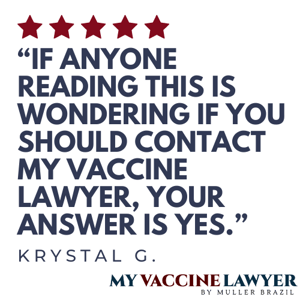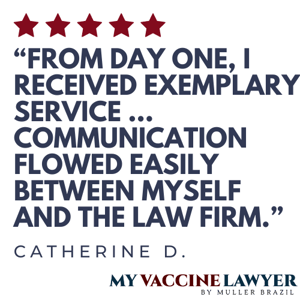Vaccines
In modern medicine, vaccines are one of the most remarkable achievements in human history.
With their ability to prevent the spread of infectious diseases and save countless lives, vaccines have transformed our world.
Is SIRVA permanent?
Our Founder Paul Brazil explains what a shoulder injury related to vaccine administration entails, how common it is, and more. SIRVA is the most common injury in the Vaccine Injury Compensation Program.
What is a Vaccine?
Vaccines have proven to be powerful tools in the fight against deadly pathogens, from eradicating smallpox to curbing the devastating impact of polio.
To demonstrate the vast effect and influence vaccines have in society, then consider this: After more than a year of the largest vaccination campaign in history, a staggering 12.7 billion COVID-19 doses had been administered across 184 countries as of October 5th, 2022, according to data collected by Bloomberg.
However, despite the undeniable success of some, vaccines have also faced skepticism and cynicism, leading to vaccine hesitancy. This article will explore the science behind vaccines and their impact on public health and address common concerns surrounding their safety and efficacy.
A vaccine is a biological preparation that stimulates the immune system to recognize and defend against specific pathogens. It contains weakened or inactivated forms of the pathogen or its components, triggering an immune response that leads to protection against the disease. Vaccines are typically delivered via needle injections, although some can be administered orally or through nasal sprays.
Hear Cheryl's Vaccine Injury Story
Cheryl suffered SIRVA (shoulder injury related to vaccine administration) following a flu shot. Her vaccine injury claim was filed in the VICP by vaccine lawyer Max Muller where she obtained a large cash settlement for her pain and suffering, lost wages and out of pocket medical expenses.
What is the purpose of vaccines?
The purpose of a vaccine is to stimulate the immune system and provide protection against specific infectious diseases. Vaccines trigger an immune response by introducing a safe pathogen quantity or its components into the body. This response leads to the production of antibodies and the development of memory cells that can recognize and quickly respond to the pathogen in case of future exposure. Vaccines aim to prevent or reduce the severity of infections, safeguarding individuals and communities from the diseases they target.
What makes up a vaccine?
A vaccine comprises various components that stimulate the immune system and protect against specific diseases. The key elements of a vaccine include the antigen, which is usually derived from the dead form of the pathogen. Adjuvants may be added to enhance the immune response, while stabilizers and preservatives help maintain the vaccine's integrity and sterility. Diluents are used to prepare the vaccine for administration. Although the composition of vaccines can vary depending on the type and manufacturing process, their ultimate goal remains consistent: to stimulate immunity and safeguard individuals from infectious diseases.

4,500
1,750+
5 Stars
What are uses for vaccines?
Vaccines have many uses and play a vital role in public health. Some of the primary uses for vaccines include:
- Prevention of Infectious Diseases: Vaccines are primarily used to prevent infectious diseases. By stimulating the immune system, vaccines help the body recognize and fight specific pathogens, reducing the risk of infection and the spread of diseases.
- Eradication and Control of Diseases: Vaccines have been instrumental in eradicating or significantly reducing the prevalence of many diseases. For example, smallpox has been eradicated globally through vaccination efforts.
- Protection of Individuals: Vaccines directly protect individuals by reducing their susceptibility to specific diseases. By building immunity, vaccines help individuals avoid infection or experience milder symptoms if exposed to the targeted pathogens.
- Community Immunity (Herd Immunity): Vaccines contribute to community immunity, also known as herd immunity. When a significant portion of a population is vaccinated, it creates a protective barrier, reducing the likelihood of disease transmission and protecting vulnerable individuals who cannot be vaccinated due to health conditions.
- Travel and Global Health: Vaccines are important for international travel. Certain countries may require proof of vaccination against specific diseases as a condition for entry. Additionally, vaccines play a crucial role in global health efforts, especially in regions where infectious diseases are endemic.
- Research and Development: Vaccines drive research and development in immunology and public health. Ongoing advancements in vaccine technology and development help address emerging diseases, improve vaccine effectiveness, and expand the range of diseases that can be prevented through vaccination.
Vaccines are essential in preventing, controlling, and even eliminating diseases, improving individual and public health globally.

What Are The Different Types of Vaccines?
There are six primary types of vaccines:
- Live Attenuated Vaccines contain weakened, but still living, forms of the pathogen. A live vaccine closely mimic natural infections and provide a strong and long-lasting immune response. Examples include the measles, mumps, and rubella (MMR) vaccine.
- Inactivated Vaccines use killed or inactivated forms of the pathogen. While they cannot replicate in the body, they still stimulate an immune response. Examples include the hepatitis A vaccine and the polio vaccine (inactivated poliovirus vaccine, IPV).
- Toxoid Vaccines target diseases caused by bacterial toxins. They use inactivated toxins produced by the pathogen to stimulate an immune response. Examples include diphtheria and tetanus vaccines.
- Subunit and Conjugate Vaccines comprise specific pieces (subunits) of the pathogen, such as proteins or sugars, to trigger an immune response. Conjugate vaccines link the pathogen's polysaccharide coat (bacterial cell protection) to a protein. Examples include the hepatitis B vaccine (a subunit vaccine) and the Haemophilus influenza type B (Hib) vaccine (a conjugate vaccine).
- mRNA vaccines use a small piece of the pathogen's genetic material, messenger RNA (mRNA), to instruct cells to produce harmless viral proteins. This prompts the immune system to recognize and respond to those proteins. Examples include the Pfizer-BioNTech and Moderna COVID-19 vaccines.
- Viral Vector Vaccines contain harmless viruses or bacteria as carriers, or vectors, to deliver specific genes from the pathogen into the body. The genes then produce the desired antigens, triggering an immune response. Examples include the Johnson & Johnson COVID-19 vaccine (adenovirus vector-based) and the oral polio vaccine (live attenuated, oral poliovirus vaccine, OPV).
What Diseases do Vaccines prevent?
The following is a list of the diseases and the vaccines that help prevent them with information courtesy of the World Health Organization (WHO) and the Centers for Disease Control and Prevention (CDC):
Diphtheria is caused by strains of bacteria known as Corynebacterium diphtheriae, which is a severe infection characterized by toxin production. It can result in challenges with breathing, heart rhythm abnormalities, and potentially fatal outcomes. The Centers for Disease Control and Prevention (CDC) advises the Tdap vaccination for infants and children under 7. Persons over 7 are recommended to take the DTaP vaccine to prevent diphtheria.
Hepatitis A is a liver infection caused by the hepatitis A virus (HAV) that can be prevented through vaccination. HAV is present in the blood and feces of infected individuals, making it highly contagious. Transmission of the virus occurs when an individual unintentionally consumes the virus, even in minuscule quantities, either through close personal contact with an infected person or by consuming contaminated food or beverages. The Hepatitis A vaccine is an inactivated vaccine.
Hepatitis B is a liver infection caused by the hepatitis B virus (HBV) that can be prevented through vaccination. The transmission of hepatitis B occurs when blood, semen, or other body fluids from an infected person enter the body of an uninfected individual. This can happen through sexual contact, sharing needles or drug-injection equipment, or during pregnancy or delivery.
Hepatitis B vaccine is usually given as 2, 3, or 4 shots. The birth dose of the Hepatitis B vaccine is an important part of preventing long-term illness in infants and the spread of hepatitis B.
Hepatitis D is a liver disease caused by the hepatitis D virus (HDV). Referred to as a "satellite virus," HDV can only infect individuals infected with hepatitis B (HBV). HDV infection can manifest as either an acute illness or progress to a chronic, long-term condition. It can be acquired concurrently with HBV as a coinfection or as a superinfection in individuals chronically infected with HBV.
While a specific vaccine for hepatitis D does not exist, immunization with the hepatitis B vaccine offers protection against HDV infection.
Haemophilus Influenzae disease is collectively named after various illnesses caused by a bacteria known as H. Influenzae. These range from mild conditions like ear infections to more severe such as bloodstream infections. It's worth noting that despite its name, H. Influenzae is not responsible for causing influenza (the flu). However, vaccines are available to prevent one type of H. Influenzae disease, specifically type b or Hib.
Human Papillomavirus (HPV) is transmitted through close skin-to-skin contact, particularly during intimate activities. Engaging in vaginal, anal, or oral sex with an individual who carries the virus can result in HPV transmission, even if they do not exhibit any visible signs or symptoms. Alarmingly, over 42 million Americans are infected with HPV strains that can lead to various diseases, according to the CDC.
The administration of HPV vaccination is advised between the ages of 11 and 12. However, HPV vaccines can be initiated as early as 9. It is crucial for all preteens to receive HPV vaccination to safeguard against HPV infections, which can potentially lead to cancer in later stages of life.
Influenza is an infectious respiratory illness caused by influenza viruses that invade the nose, throat, and occasionally the lungs. It can result in mild to severe symptoms and, in some cases, even fatalities. The most effective method to prevent the flu is by receiving an annual flu vaccine. The general consensus among experts is that flu viruses primarily spread through minuscule droplets generated when individuals with the flu cough, sneeze, or speak.
Measles is a viral infection from the paramyxovirus family, typically transmitted through direct contact and airborne particles. The virus initially infects the respiratory tract and subsequently disseminates throughout the body, leading to severe illness, complications, and potentially fatal outcomes. Before introducing the measles vaccine in 1963 and its subsequent widespread use, significant epidemics arose approximately every two to three years, resulting in an estimated 2.6 million deaths annually.
The Meningococcal Disease accounts for various illnesses triggered by the Neisseria meningitidis bacteria. These illnesses, which comprise Meningitis (infections of the brain and spinal cord lining) and bloodstream infections, are typically severe, potentially fatal, and require urgent medical attention.
Vaccinations provide the most effective defense against Meningococcal Disease. Additionally, practicing healthy habits such as getting sufficient rest and minimizing close contact with individuals who are ill can further contribute to prevention.
Mumps is an infectious illness resulting from a viral infection. It commonly begins with several days of symptoms such as fever, headache, muscle pain, fatigue, and decreased appetite. Subsequently, individuals typically experience swelling of the salivary glands, known as parotitis, when the parotid gland, situated in front and below the ear, becomes enlarged. This swelling leads to the characteristic appearance of puffy cheeks and a tender, swollen jaw. Although individuals who have received the mumps vaccine may still contract the virus when exposed, the symptoms experienced by vaccinated individuals tend to be less severe.
Pertussis, commonly known as whooping cough, is an extremely contagious respiratory illness caused by a bacteria called Bordetella pertussis. This disease exclusively affects humans.
The bacteria responsible for whooping cough adhere to the cilia, which are tiny hair-like structures lining the upper respiratory system. The bacteria easily transmit from person to person through airborne means.
In the United States, two vaccines, DTaP and Tdap, are available to prevent whooping cough. These vaccines also offer protection against tetanus and diphtheria.
Streptococcus Pneumoniae is a bacteria responsible for various infections ranging from ear and sinus infections to pneumonia and bloodstream infections. Fortunately, vaccines are available to aid in preventing pneumococcal disease. The two available vaccines protect against many, but not all, types of pneumococcal bacteria, and their effectiveness is not 100%. Hence, there is still a chance of developing pneumococcal disease after vaccination.
Polio is a serious and potentially fatal illness caused by poliovirus. It is highly contagious and can invade the spinal cord, leading to paralysis and the inability to move certain body parts. Approximately 25% of individuals infected with the poliovirus will experience flu-like symptoms. These symptoms typically persist for 2 to 5 days and resolve without treatment. A smaller percentage of those infected may develop more severe symptoms that impact the brain and spinal cord.
The polio vaccine safeguards children by priming their immune systems to combat the poliovirus. When administered in the recommended doses, the inactivated polio vaccine protects against polio for over 99 percent of children.
Rotavirus frequently leads to severe watery diarrhea and vomiting episodes in infants and young children. This can result in dehydration, necessitating hospitalization, and can be fatal in severe cases. Individuals infected with rotavirus release the virus through their feces, which is how it enters the environment and can potentially infect others. Even if children have received the rotavirus vaccine, they can still experience infection and illness from rotavirus on multiple occasions. Natural infection with rotavirus and vaccination does not offer complete protection against future infections.
Rubella is a contagious disease. Those infected with rubella typically experience a mild illness characterized by symptoms like a low-grade fever, sore throat, and a rash that initially appears on the face and gradually extends to other body parts. However, if a woman contracts rubella during pregnancy, it can lead to miscarriage or severe birth defects in the developing baby.
There is no specific medication to treat rubella. In most instances, symptoms tend to be mild. For individuals with mild symptoms, rest and fever-reducing medications like acetaminophen can help manage the condition.
Shingles is caused by the varicella-zoster virus (VZV), which is the same virus responsible for chickenpox. Following recovery from chickenpox, the virus remains dormant within the body. However, it can reactivate many years later, resulting in shingles. Approximately one in every three individuals will experience shingles in the United States.
To prevent shingles and associated complications among adults 50 years and older, the Centers for Disease Control and Prevention (CDC) recommends administering two doses of recombinant zoster vaccine (RZV), known as Shingrix. Individuals aged 19 and older with weakened immune systems due to disease or treatment are also advised to receive the Shingrix vaccine.
Tetanus, also known as 'lockjaw,' is an infection caused by Clostridium tetani. When these bacteria enter the body, they release a toxin that triggers painful muscle contractions. This condition can lead to the locking of neck and jaw muscles, resulting in difficulty opening the mouth or swallowing. Tetanus bacteria typically enter the body through broken skin, particularly wounds contaminated with dirt, feces, or saliva, puncture wounds, burns, crush injuries, or injuries involving dead tissue. In the United States, four types of vaccines are utilized to prevent tetanus, all offering protection against other diseases.
Chickenpox is an extremely contagious disease characterized by an itchy rash that resembles blisters. The rash typically emerges on the chest, back, and face before spreading across the body. The contagious nature of chickenpox is significant, as up to 90% of individuals close to an infected person who lack immunity can also become infected. The disease can be severe, even life-threatening, particularly in infants, adolescents, adults, pregnant women, and individuals with weakened immune systems. Vaccination is crucial in safeguarding oneself, family members, and the wider community. This is especially vital to protect those who cannot receive the vaccine, such as individuals with weakened immune systems or pregnant women.
COVID-19 typically manifests with respiratory symptoms that resemble those of a cold, flu, or pneumonia. However, the impact of the disease extends beyond the respiratory system, affecting various parts of the body. While most individuals experience mild symptoms, some can develop severe illness. The transmission of COVID-19 occurs when an infected person exhales droplets and tiny particles containing the virus. Others can inhale these droplets or come into contact with their eyes, nose, or mouth. The virus can potentially contaminate surfaces touched by these droplets.
There are many vaccinations available for the numerous variants of COVID-19. Researching the vaccinations will help make a more informed choice.
What vaccines do I have to get?
Depending on social policy, the number of required or mandated vaccines differs from country to country and possibly state to state, so this can be difficult to answer. We recommend that you check your local government guidelines for specific answers. The information is available in easy-to-read formats like the following table demonstrating the vaccine policies per country in Europe. Generally speaking, according to BMC Health Services, countries will either recommend or mandate all vaccines. Belgium is one interesting example where all vaccines are recommended except for the Poliovirus, which is mandatory for citizens.
There are several different approaches to determining whether you need a vaccine. Different age groups are more susceptible to certain illnesses and diseases. For example, a younger individuals between 19 and 26 would be wise to stay updated regarding their vaccinations for HPV. In contrast, more senior age groups have understandable higher health risks and thus would need to consider the shingles and pneumococcal jabs.
Life events, jobs, and travel are common reasons to consider when vaccines are necessary.
For example, protecting your baby against Pertussis during pregnancy is recommended by receiving the Tdap vaccine between weeks 27 and 36.
Healthcare workers should ensure they are up-to-date with their vaccine status, as there is an increased risk of infection when working with vulnerable people. International travel requires certain vaccines. Thus, being acutely aware of the necessary immunizations is an excellent idea. Get more travel vaccination information and where to find vaccinations at CDC’s Travelers’ Health Clinic.
Children’s Vaccination Schedule
Vaccination schedules for children are key to maintaining healthy and sustained development. A child's various developmental stages help significant physical, emotional, and cognitive growth. However, due to these ongoing changes, some vulnerabilities open up. We highly recommend revising the following vaccination schedule chart provided by the CDC to help give your child the best opportunity to stay healthy.
What vaccines do children have to get?
Vaccinating infants, children, and teens is a highly effective method for parents to safeguard them against several potentially dangerous diseases. These diseases can have severe consequences, leading to hospitalization or even fatality. It's important to note that immunizations are not limited to childhood. Some vaccines' protection can diminish over time, emphasizing the significance of staying up to date with vaccinations throughout life.
The immunization schedule for the first 2 years of a baby’s life is very busy. Still, it is crucial to stick to this rigorously to avoid any unnecessary health complications during an extremely important stage of development.
The list of vaccines recommended for young children is extensive, but they include:
- Hepatitis B
- Diphtheria
- Tetanus
- Pertussis
- Hib
- Polio
- Pneumococcal
- Rotavirus
- Influenza
- Chickenpox
- Measles, Mumps and Rubella
- Hepatitis A
What vaccines do I need If I get pregnant?
During pregnancy, the CDC advises administering the inactivated flu vaccine and the Tdap vaccine. The flu vaccine is recommended to be received by the end of October, but getting it later in the flu season can still provide benefits. Scientific evidence confirms the safety of the flu vaccine for pregnant women, making it an effective method to shield both the mother and the baby from flu-related complications.
The Tdap vaccine, which protects against whooping cough, is recommended anytime during pregnancy, preferably between 27 and 36 weeks. This vaccine is encouraged for every pregnancy, irrespective of previous Tdap vaccination. In cases where the Tdap vaccine was not received during or before pregnancy, the CDC advises immediate vaccination after childbirth.
What are vaccine side effects?
Vaccine side effects are typically mild and temporary, indicating that the vaccine is working to stimulate the immune system. Common vaccine side effects may include soreness, redness, swelling at the injection site, low-grade fever, fatigue, or muscle pain. These reactions usually resolve on their own within a few days. Vaccine safety is monitored through rigorous testing and ongoing surveillance by healthcare authorities and regulatory bodies. Suppose you have concerns about your side effects. In that case, it is recommended to discuss them with a healthcare professional who can provide accurate information and address any specific questions or considerations you may have.
What vaccine injuries can happen?
It's important to note that vaccine injuries are exceedingly rare compared to the number of people vaccinated. The benefits of vaccination in preventing serious diseases far outweigh the risks of potential side effects. While vaccines are generally safe and effective, like any medical intervention, they can have potential risks and side effects. Vaccine injuries, although extremely rare, can occur. Some of the possible vaccine injuries include:
- Allergic reactions: Severe allergic reactions to vaccines, known as anaphylaxis, can occur but are rare. Signs of an allergic reaction may include difficulty breathing, hives, swelling, or rapid heartbeat.
- Shoulder injury related to vaccine administration (SIRVA): Improper vaccine administration can lead to shoulder injuries such as tendonitis, bursitis, or adhesive capsulitis (frozen shoulder). These injuries are rare and typically result from an incorrect injection technique.
- Guillain-Barré Syndrome (GBS): GBS is a rare neurological condition associated with certain vaccines, including influenza. It causes muscle weakness, tingling sensations, and, in severe cases, paralysis. However, the risk of developing GBS after vaccination is very low.
Other vaccine injuries exist so it is recommended to review the Vaccine Injury Table as provided by the Vaccine Injury Compensation Program (VICP).
If I have been injured, can I get compensation?
Yes! You can seek compensation for an injury caused by a vaccine.
When the vaccine meant to protect you ends up causing harm, it can feel frustrating and confusing. On top of it, the process of filing for compensation is complicated. You're not alone; our vaccine injury lawyers are here to help. Suppose you were injured by a covered vaccine in the United States. In that case, you can file a claim in the Vaccine Injury Compensation Program (VICP). Our vaccine injury lawyers make this overwhelming legal process simple for you.
To work towards getting you the compensation you deserve as quickly as possible, our legal team will:
- Help you understand your vaccine-related injury and evaluate your next steps.
- Consult leading medical experts to offer medical support to win your case.
- File your vaccine injury claim and corresponding medical records and litigate your case from start to finish.
We handle the logistics and keep you informed every step of the way. It gives us tremendous pride to hear our clients say that our human approach sets us apart from other vaccine law firms.

